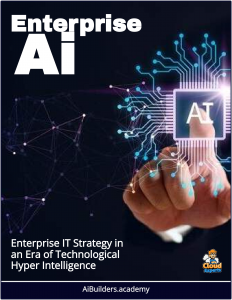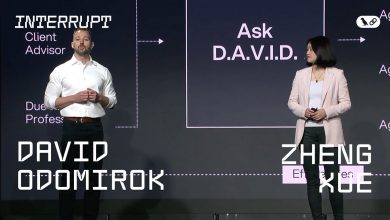Enterprise AI: Turning Ideas into Action
Exploring how enterprise leaders can bridge the gap between AI’s promise and its execution, delivering transformative results.
 How do you turn Artificial Intelligence (AI) concepts into measurable business success?
How do you turn Artificial Intelligence (AI) concepts into measurable business success?
John Roese, Dell Technologies Global CTO and Chief AI Officer, reveals how to identify high-impact use cases and move them into production.
Discover actionable strategies to harness data, deploy AI effectively and deliver outcomes that transform the productivity of your organization.
Enterprise AI: Turning Ideas into Action
In today’s hyper-competitive business landscape, artificial intelligence (AI) is no longer a futuristic concept—it’s a strategic imperative. For CIOs and CEOs, the challenge isn’t just understanding AI’s potential but translating it into tangible outcomes that drive productivity, innovation, and growth. The key lies in actionable strategies that harness data, deploy AI effectively, and align it with organizational goals.
1. Start with the Data Foundation
AI thrives on data—it’s the fuel that powers intelligent systems. Yet, many organizations struggle with fragmented, siloed, or poor-quality data. For AI to deliver value, CIOs must prioritize building a robust data foundation.
- Actionable Strategy: Conduct a data maturity assessment to identify gaps in data quality, accessibility, and governance. Invest in a unified data architecture—whether through cloud platforms, data lakes, or hybrid solutions—that enables real-time access and scalability. For example, a global retailer recently consolidated its customer data into a single platform, enabling AI-driven personalization that boosted sales by 15% within six months.
- Key Insight: AI is only as good as the data it’s trained on. Clean, structured, and secure data isn’t a luxury—it’s a prerequisite.
2. Align AI with Business Outcomes
Too often, AI initiatives fail because they lack a clear connection to business objectives. Deploying AI for the sake of innovation risks wasting resources on tools that don’t move the needle. Instead, CEOs and CIOs must anchor AI projects in specific, measurable goals—whether it’s reducing operational costs, enhancing customer experience, or accelerating product development.
- Actionable Strategy: Begin with a top-down approach. Identify high-impact use cases by collaborating with business unit leaders to pinpoint pain points or opportunities. For instance, a manufacturing firm used AI-powered predictive maintenance to reduce equipment downtime by 30%, directly improving throughput. Define KPIs upfront—cost savings, revenue growth, or customer satisfaction scores—and track them rigorously.
- Key Insight: AI isn’t a silver bullet; it’s a tool to solve defined problems. Success comes from ruthless prioritization.
3. Scale Smart with Pilot-to-Production Frameworks
Many organizations get stuck in the pilot phase, where AI experiments dazzle but don’t scale. Moving from proof-of-concept to enterprise-wide deployment requires a structured approach that balances speed, risk, and impact.
- Actionable Strategy: Adopt a “pilot-to-production” framework. Start small with a controlled pilot—say, automating a single process like invoice processing with AI-powered optical character recognition (OCR). Measure results, refine the model, and then scale it across departments. A financial services firm recently scaled an AI chatbot from one customer service team to a global operation, cutting response times by 40% and saving $10 million annually.
- Key Insight: Scaling isn’t just technical—it’s cultural. Involve stakeholders early to build buy-in and address resistance.
4. Empower Your Workforce with AI Literacy
AI’s success hinges on people as much as technology. A workforce unprepared for AI-driven change can bottleneck progress. CIOs and CEOs must invest in upskilling employees to work alongside AI tools effectively.
- Actionable Strategy: Launch an AI literacy program tailored to different roles. For technical teams, focus on hands-on training in machine learning platforms. For business leaders, emphasize how to interpret AI insights and make data-driven decisions. A healthcare provider trained its staff to use an AI diagnostic tool, reducing diagnostic errors by 25% and boosting clinician confidence.
- Key Insight: AI augments human capability, not replaces it. An AI-ready workforce is your competitive edge.
5. Leverage Partnerships and Ecosystems
Building AI in-house can be resource-intensive, especially for organizations without deep expertise. Strategic partnerships with AI vendors, cloud providers, or consultancies can accelerate deployment and reduce risk.
- Actionable Strategy: Evaluate your AI maturity and partner accordingly. For foundational capabilities, lean on established platforms like Google Cloud AI or Microsoft Azure. For niche solutions—think supply chain optimization or fraud detection—tap specialized vendors. A logistics company partnered with an AI startup to optimize delivery routes, cutting fuel costs by 20% in under a year.
- Key Insight: You don’t need to own every piece of the AI puzzle—ecosystems amplify your reach.
6. Embed Ethics and Governance from Day One
As AI scales, so do its risks—bias, privacy breaches, and regulatory non-compliance can derail even the best initiatives. Proactive governance ensures AI delivers value without compromising trust.
- Actionable Strategy: Establish an AI ethics framework that includes clear policies on data usage, model transparency, and accountability. Appoint a cross-functional AI oversight team to monitor compliance and address issues. A bank implemented an AI governance board, catching a biased lending algorithm before it went live, saving millions in potential fines.
- Key Insight: Ethical AI isn’t optional—it’s a business necessity in a world of heightened scrutiny.
The Transformation Payoff
When executed well, enterprise AI doesn’t just improve efficiency—it redefines what’s possible. Consider a telecom giant that used AI to predict network outages, slashing downtime by 50% and boosting customer satisfaction. Or a retailer that deployed AI-driven demand forecasting, reducing inventory waste by 35%. These aren’t isolated wins—they’re proof that AI, when aligned with strategy and execution, can transform productivity at scale.
The Path Forward
For CIOs and CEOs, the mandate is clear: AI’s potential is vast, but its value lies in action. Start with your data, anchor efforts in outcomes, scale smartly, empower your people, leverage ecosystems, and govern responsibly. The organizations that master this playbook won’t just adapt to the future—they’ll shape it.
The time to act is now. Your enterprise’s next breakthrough isn’t in the idea of AI—it’s in how you turn it into reality.



